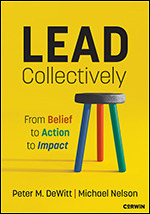Lead Collectively
From Belief to Action to Impact
- Peter M. DeWitt - Corwin Author and Consultant
- Michael Nelson - Assistant Executive Director for Professional Learning, Washington Association of School Administrators
Afterword by Chris Beals, Foreword by Michael Butler, Sylvie Arseneau, and Rosemary Southard
A new way to think together, work together, and impact students… together.
Despite regular meetings and planning sessions, collective leader efficacy often remains an untapped resource, leaving leadership teams working in silos and increasing the challenge of creating environments where every student and adult can thrive. Lead Collectively bridges this gap by providing a comprehensive framework for shared understanding, joint work, and evidence-based decision-making to strengthen leadership teams and amplify their impact on teaching and learning.
Drawing on decades of leadership experience and research, authors Peter M. DeWitt and Michael Nelson offer actionable tools, protocols, and insights to help educational leaders foster trust, coherence, and accountability. Additional features include:
- A step-by-step Collaborative Inquiry Cycle to guide leadership teams from identifying problems of practice to tracking measurable results
- Guidance on integrating AI tools to analyze data, assess impact, and enhance collaboration
- Case studies and real-world stories illustrating how schools and districts have transformed their leadership practices through collective efficacy
Peter and Michael’s work has helped Arkansas Leadership Academy participants unify the hard data sets that often inform decisions with
the intangibles of a classroom and school to create mission- and vision-guided work. Building momentum through collective action and informed
leadership with these tools has helped us identify gaps in educator understanding and improve outcomes for students across our state.
Peter and Michael have crafted a compelling literary experience that immerses readers in a rich tapestry of stories, thought-provoking
questions, and meaningful reflections, all firmly rooted in research. It’s a must-read for anyone passionate about empowering students and staff
in K–12 education, offering practical strategies, innovative tools, and powerful insights to help every learner thrive.
Peter and Mike clearly articulate and unpack the values, skills, and culture that underpins high-quality, impactful student-centered leadership in
education. This book is a must-read for all educators.
Lead Collectively is a timely and useful resource for leadership teams seeking to transform their impact. By emphasizing collective responsibility,
continuous learning, and evidence-informed action, it provides a much needed bridge between theory and practice. Educators and school leaders
will find in it not just a call to action, but a map for how to walk the talk—together.
